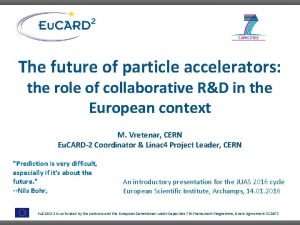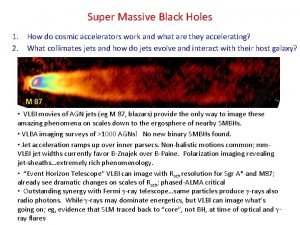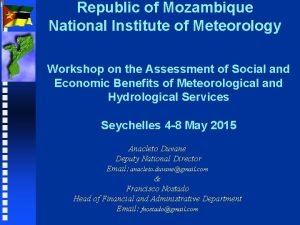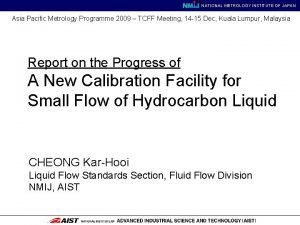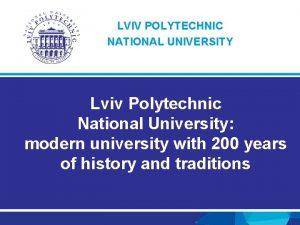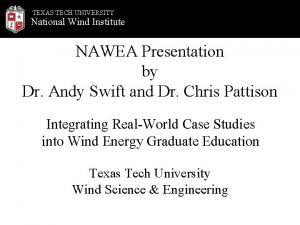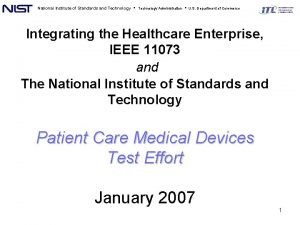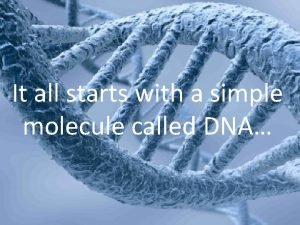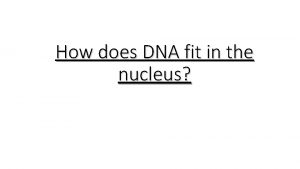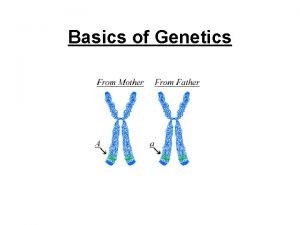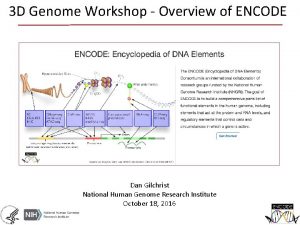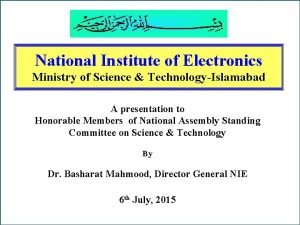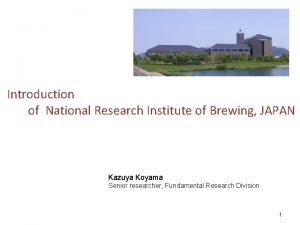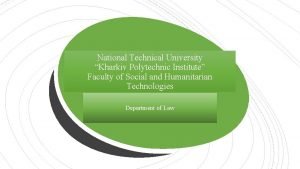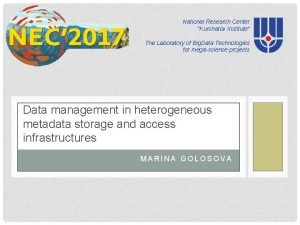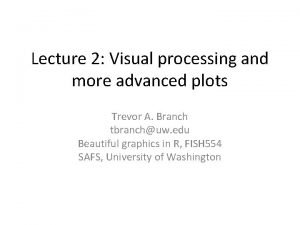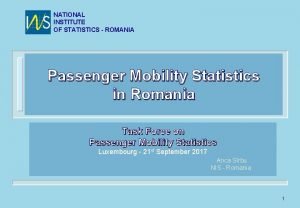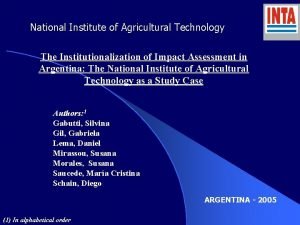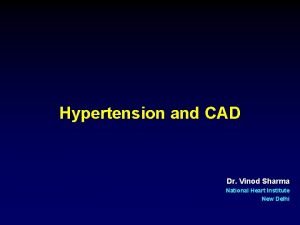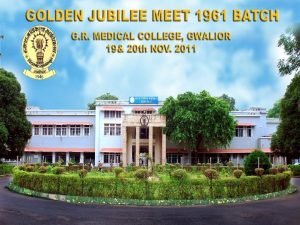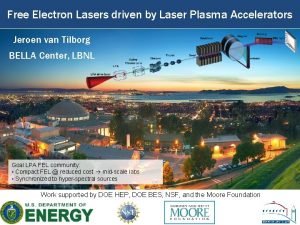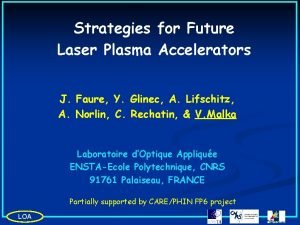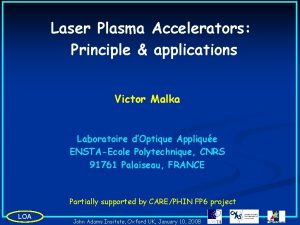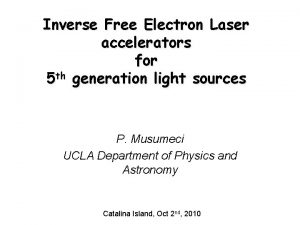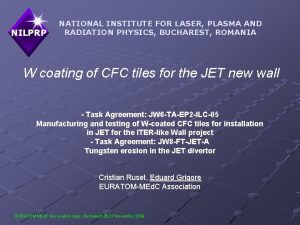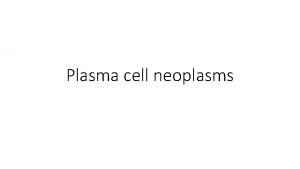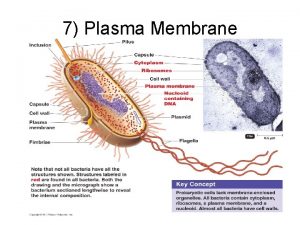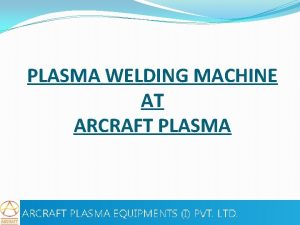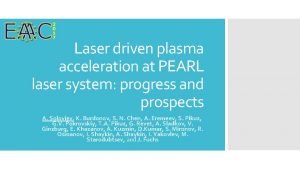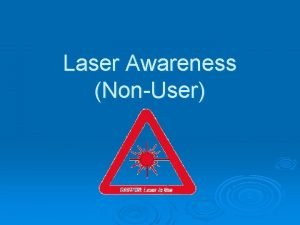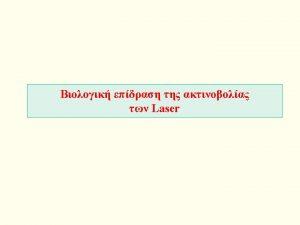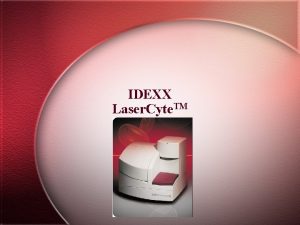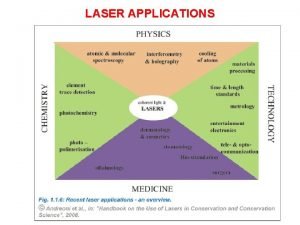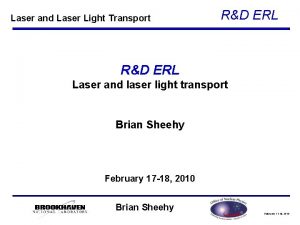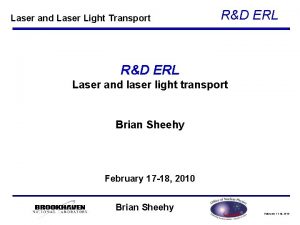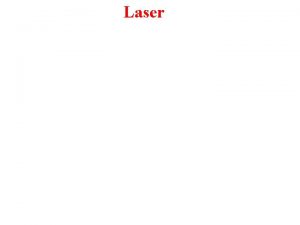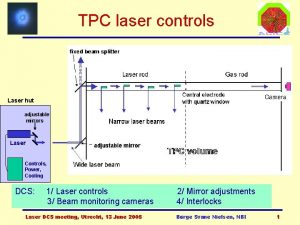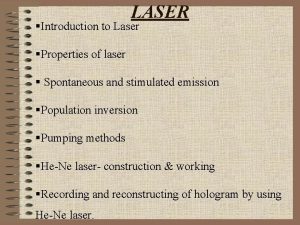Electron accelerators in National Institute for Laser Plasma











































- Slides: 43

Electron accelerators in National Institute for Laser, Plasma and Radiation Physics Characteristics and areas of application Diana MARTIN Daniel IGHIGEANU Ioan CALINESCU The industrial and environmental applications of electron beams - Warsaw 2014 1

The features of industrial electron linear accelerators (linacs) are of critical importance to permit efficient energy utilization, reliable operation, beam parameters stability, absorbed dose rate determination, measurement and control of beam characteristics. Several linac models were specially designed and built in the Accelerators Laboratory of the National Institute for Lasers, Plasma and Radiation Physics (INFLPR) – Bucharest, Magurele (Romania) to: • carry out the research in the radiation processing field, • to develop radiation technologies and • to provide small-scale commercial irradiation services. In INFLPR, the first traveling-wave electron linac, AL-3 of 3 Me. V, was built in 1965 and have been in operation until 1978. Years of research combined with engineering activities have culminated in the development of two electron linacs of higher energy: ALIN‑ 10 in 1977 and ALID‑ 7 in 1982. These two linacs have been in successful operation with several improvements until now. The industrial and environmental applications of electron beams - Warsaw 2014 2

The ALIN-10 accelerator is a laboratory installation located in a horizontal position inside the irradiation room and is equipped with a post-acceleration beam focusing and bending to project accelerated EB either on the accelerating structure axis or at right angles to the accelerator structure. The industrial and environmental applications of electron beams - Warsaw 2014 3

The optimum values of the EB peak current IEB and EB energy EEB to produce maximum output power PEB for a fixed pulse duration EB and repetition frequency f. EB are as follows: EEB = 6. 23 Me. V; IEB =75 m. A; PEB = 164 W (f. EB = 100 Hz, EB = 3. 5 s) The industrial and environmental applications of electron beams - Warsaw 2014 4

The accelerator ALID-7 is an industrial equipment initially designed and optimized to produce maximum X-ray output for nondestructive testing. Both accelerators, ALIN‑ 10 and ALID‑ 7, are of travelling‑wave type, driven by 2 MW peak power tunable E 2 V M 5125 type magnetrons operating in S-band (2992 to 3001 MHz). The industrial and environmental applications of electron beams - Warsaw 2014 5

The optimum values of the EB peak current IEB and EB energy EEB to produce maximum output power PEB for a fixed pulse duration EB and repetition frequency f. EB are as follows: ALID-7: EEB = 5. 5 Me. V; IEB =130 m. A; PEB = 670 W (f. EB = 250 Hz, EB = 3. 75 s) The industrial and environmental applications of electron beams - Warsaw 2014 6

An important feature of ALIN-10 and ALID-7 accelerators is the original EB control method for obtaining programmed beam single shots and pulse trains from a diode gun linear electron accelerator by discrete pulse position modulation of gun and magnetron pulses. This technique combines the unsophisticated construction of diode guns and better temporal flexibility of the beam, generally available when using triode electron guns. A method for the 2. 45 GHz Magnetron Output Power Control, D. Martin, A. Jianu, D. Ighigeanu, IEEE Transactions on Microwave Theory and Techniques, Vol. 49, No. 3, March 2001, pp. 542 -544 Discrete pulse temporal position modulation method applied to the gun pulses and some temporal distributions of EB pulses (a) magnetron and gun pulses are shifted (no accelerated EB); (b) M and G pulses are overlapped (accelerated EB start); (c) 2 nd, 3 rd an 4 th G pulses are shifted to overlap with the corresponding M pulses (three accelerated EB are delivered); (d) 2 nd, 3 rd an 4 th G pulses are partially shifted to overlap with corresponding M pulses (three accelerated EB with different duration are nd, 4 th, 6 th, etc. The industrial and environmental delivered); (e) 2 nd G pulses is shifted to overlap a single M pulse (single accelerated EB pulse is delivered); (f) 2 7 applications of electron beams - Warsaw G pulses are shifted to overlap the corresponding M pulses (EB repetition period is 2 T) 2014

These accelerators were used to develop new technologies in the field of: • environmental depollution, • processing of polymers and rubbers, • food preservation, • biomedicine, • generation of nanoparticles, etc It was developed an original method for materials processing based on the addition of microwave energy to electron beam energy in order to obtain materials with improved properties, processing high yields and to reduce the electron absorbed dose and irradiation time to a minimum, thus reducing irradiation cost. The effects of combined EB and MW irradiation were investigated for the following material processes: Removal of SO 2 and NOx from flue gases Volatile organic compounds removal Obtaining of polymeric materials Obtaining of rubber materials Biological waste treatment Applications in biomedicine Combined Microwave and Accelerated Electron Beam Irradiation Facilities for Applied Physics and Chemistry, D. Martin, D. Ighigeanu, E. Mateescu, G. Craciun, I. Calinescu, H. Iovu. G. Marin, IEEE Transactions on Industry Applications, vol. 40, no. 1, Juanuary/February 2004 pp. 1 -12 The industrial and environmental applications of electron beams - Warsaw 2014 8

Removal of SO 2 and NOx from flue gases by technologies based on "Non-Thermal Plasma” From the results obtained by basic studies and pilot plant tests, irradiation with electron beams (EB) was considered to be an effective method for simultaneous removal of SO 2 and NOx. But, the required absorbed dose level and electrical energy consumption is still too high. In view of these arguments, we have been attracted during the last years to the concept of microwave (MW) energy additional use to EB energy. We have considered in our research that the microwave induced plasma chemical process could be an attractive alternative to DC or pulse corona induced plasma chemical process. A semi-pilot installation that permits: • separate MW processing, • separate EB processing • and simultaneous MW+EB processing was carried out for the SO 2 and NOx removal from flue gases. The industrial and environmental applications of electron beams - Warsaw 2014 9

The equipment consists mainly of the following units: a gaseous mixture preparation system, a microwave source, an electron beam source (ILU 6 M 2 Me. V and 10 k. W) and a multimode rectangular cavity, used as reaction chamber, in which are injected both MW and EB fields. The MW+EB processing increases strongly NOx removal efficiency, up to 95%, as compared with MW treatment only, simultaneously providing very high values for the SO 2 removal efficiency, near 100%. The MW+EB processing could be a promising method for flue gas cleaning, especially for simultaneous SO 2 and NOx removal. The industrial and environmental applications of electron beams - Warsaw 2014 10

ISI PAPERS New method for removal of SO 2 and NOx from combustion flue gases, D. Martin, D. Niculae, M. Radoiu, I. Indreias, R. Cramariuc, A. Margaritescu, Journal of Microwave Power and Electromagnetic Energy, Vol 32(4), 1997 pp. 215 -219 A laboratory test unit for exhausted gas cleaning by electron beam and combined electron beam-microwave irradiation, M. Radoiu, D. Martin, I. Georgescu, I. Calinescu, V. Bestea, I. Indreias, C. Matei, Nuclear Instruments and Methods in Physics Research B 139, 1998 pp. 506 -510 Emission control of SO 2 and NOx by irradiation methods, M. Radoiu, D. Martin, I. Calinescu , Journal of Hazardous Materials, B 97, 2003, pp. 145 -158 SO 2 and NOx removal by electron beam and electrical discharge induced non-thermal plasmas, D. Ighigeanu, D. Martin, E. Zissulescu, R. Macarie, C. Oproiu, E. Cirstea, H. Iovu, I. Calinescu, N. Iacob, VACCUM, Volume 77, Issue 4, 2005, pp. 493 -500 NATIONAL RESEARCH PROJECTS: RELANSIN 593/2000 Technology for simultaneous retention of sulfur and nitrogen oxides (SO 2, NOx) from flue gases using microwave and electron beam PN II-PARTNERSHIPS in Strategic Fields 21 -025/2007: Increase of conversion performance of acidic gases from industrial gases by combined treatment with accelerated electrons and microwave PATENT: Enhancement of conversion performance of gaseous pollutants in industrial waste gases by combined treatment with accelerated electrons and microwaves Patent Number: RO 126841 -A 2 Patent Assignee: INST NAT CERC DEZVOLTARE FIZICA TEHNICA Application Date: 21 Apr 2010; Publ. Date: 30 Nov 2011 The industrial and environmental Inventor(s): IGHIGEANU D P; MARTIN D; CALINESCU I; MATEI C; MANAILA E; CRACIUN G. 11 applications of electron beams - Warsaw 2014

E-Beam SO 2 and NOx removal from flue gases in the presence of fine water droplets At this moment, at global level there are few pilot and industrial installations for flue gases treatment by electron beam (EB) irradiation. Their inconvenient is the energy consumption which is rather high (the necessary power for EB is around 2 -4% from the total electrical energy produced by the plant). That is why it is mandatory to find new solutions and to develop strategies for diminishing both the energy and the costs. The our research highlights the advantages of the high energy electron beam irradiation treatment in the presence of fine water droplets (FWD) performed into a laboratory scale installation. the gas burner that was introduced in the facility in order to burn a liquid mixture, giving gases with a composition similar to that obtained at the industrial scale the device that sprays water into the gas mixture as fine droplets 12

Electron energy losses function of incident electron energy for flue gases treatment by EB (Cleland, 2007). The influence of liquid water fraction(L) in flue gases on the density of flue gases with FWD and penetration depth for EB of 2. 5 Me. V. The industrial and environmental applications of electron beams - Warsaw 2014 13

The presence of FWD leads to an increase in the density of the medium and thus, the penetration depth of EB in the reaction medium is significantly changed. Because the reactor length is limited to 300 cm, we can consider that the ratio between the reactor length and the penetration depth provides information about the effectively used power The industrial and environmental applications of electron beams - Warsaw 2014 14

As evaluation criterion of the process were calculated pollutant (P) removal efficiency (RE), reactor energy density (RIED), and energy efficiency (EE) by using the following expressions (Zhu etal. , 2009): The industrial and environmental applications of electron beams - Warsaw 2014 15

E-Beam SO 2 and NOx removal from flue gases in the presence of fine water droplets, I. Calinescu, D. Martin, A. Chmielewski, D. Ighigeanu, Radiation Physics and Chemistry, Vol. 85, 2013, pp. 130 -138. Published PATENT at 30 Dec. 2013: PROCEDURE FOR SO 2 AND Nox REMOVAL FROM INDUSTRIAL FLUE GASES BY MEDIUM ENERGY ELECTRON BEAM TREATMENT IN THE 16 PRESENCE OF FINE WATER DROPLETS. Inventors: Ighigeanu D; Calinescu I; Martin D; Matei C.

A new hybrid technique for the volatile organic compounds removal by combined use of electron beams, microwaves and catalysts The combination of a NTP with in situ heterogeneous catalysis, denoted as “NTP catalysis” (NTPC) is considered as a promising method to improve the oxidation of VOCs and the energy efficiency of the plasma process. The catalyst presence induces an increase of the effective reaction time due to adsorption of VOCs and intermediates on the catalyst surface, resulting in a shift of the reaction selectivity towards total oxidation. Two innovative hybrid installations (HIs) for VOCs removal were carried out: HI-1 for experiments with successive EB and MW processes in two distinct reactors, both containing inside a catalyst bed; HI-2 for experiments with simultaneous EB and MW processes in the 17 same reactor containing inside a catalyst bed.

HI-1 for experiments with successive EB and MW processes in two distinct reactors, both containing inside a catalyst bed The industrial and environmental applications of electron beams - Warsaw 2014 18

HI-2 for experiments with simultaneous EB and MW processes in the same reactor containing inside a catalyst bed The industrial and environmental applications of electron beams - Warsaw 2014 19

HI-1 HI-2 20

Two efficiency types have been determined: - decomposition efficiency, Ed (the efficiency in converting VOCs to any products) and - oxidation efficiency, Eo (the efficiency for the conversion of VOCs into carbon oxides). The experiments performed with EB+MW catalysis (EB+MW-NTPC) applied in HI-1 give higher values than separate EB or separate MW, for both efficiencies, Ed and Eo. The industrial and environmental applications of electron beams - Warsaw 2014 21

The results presented in figures below are obtained by experiments performed with HI-2. All efficiencies, Ed(H), Ed(T), Ed(H+T) and Eo(H+T) increase continuously versus microwave power (PMW ) level but Eo(H+T) increases strongly versus PMW beginning with 2. 2 k. W. At low flow rate (FR) (0. 5 m 3/h) and high PMW levels (2. 2 k. W and 2. 6 k. W) there is no a notable difference between Ed(H), Ed(T) and Ed(H+T) but Eo(H+T) strongly increases compared with values obtained at FR of 1 m 3/h and 2 m 3/h. The industrial and environmental applications of electron beams - Warsaw 2014 22

ISI PAPERS A new hybrid technique for volatile organic compounds removal by combined use of electron beams, microwave and catalysts, D. Ighigeanu. I. Calinescu, D. Martin, C. Matei, Nuclear Instruments and Methods in Physics Research B, Vol. 266, No. 10, 2008, pp. 2524– 2528. VOCs Removal by Combined use of Electron Beam Microwave and Catalyst, Calinescu, I; Ighigeanu, D; Martin, D, Matei C. , Trifan A. , Oproiu C. , Revue Roumanie de Chimie , Vol. 54, No. 8, 2009, pp. 693 -698. Gaseous Pollutants Removal by Electron Beam Based Hybrid Systems, D. Ighigeanu, D. Martin, I. Calinescu, A. Bulearca, E. Manaila, G. Craciun, Revista de chimie, Vol. 63, No. 2, 2012, pp. 183 -188. NATIONAL RESEARCH PROJECTS: CEEX-AMCSIT 55/2005: Removal of volatile organic compounds from gases by combined treatment: accelerated electrons and microwaves Participation in the international project 13138 -RBF with International Atomic Energy Agency (IAEA), titled “VOC removal by combined electron beam and microwave treatment” (Nov. 2004 – Nov. 2008) part of the Coordinated Research Project (CRP) “Electron beam treatment of organic pollutants contained in gaseous streams” The industrial and environmental applications of electron beams - Warsaw 2014 23

Obtaining by electron beam and microwave irradiation of polymeric materials with new properties for efficient purification of drinking and waste water Polyelectrolytes are water-soluble polymers carrying ionic charge along the polymer chain. The inherent solid - liquid separating efficiency makes these polyelectrolytes a unique class of polymers which find extensive application in potable water, industrial raw and process water, municipal sewage treatment, mineral processing and metallurgy, oil drilling and recovery, etc Preparation of our Pn polyelectrolyte types is based on co-polymerization of aqueous solutions containing appropriate mixtures of acrylamide (AMD) and acrylic acid (AA) monomers and certain agents, such as complexing agents for impurities inhibition, chain transfer agents for cross-linked structure inhibition and initiators for monomer conversion optimization. For the preparation of acrylamide-acrylic acid copolymers our interest was focused on the basic optimization of the characteristics involved in waste water treatment, such as, conversion coefficient (CC), residual monomer concentration (Mr), intrinsic viscosity ( intr) or average Mw and linearity coefficient given by Huggins' constant (k. H). The characteristics of the AMD-AA copolymers may be influenced by the following factors: chemical composition of the solutions to be irradiated, absorbed dose level, absorbed dose rate level and the nature of the energy which induces the polymerization reaction (EB, MW The industrial and environmental and combined MW+EB). applications of electron beams - Warsaw 2014 24

The analysis of the experimental results shows that, for EB induced polymerization, for each chemical composition there is an "optimum" EB absorbed dose (D 0), which strongly depends on the absorbed dose rate (D*) level. The industrial and environmental applications of electron beams - Warsaw 2014 25

By applying combined EB irradiation and MW irradiation to appropriate mixtures of monomers in aqueous solution, it could be possible to simultaneously obtain high CC, low Mr and high Mw values as well as good water solubility. It was demonstrated that, in addition to the improvement of polymer properties, the required EB dose level and irradiation time were reduced by a factor of two in comparison with separate EB induced polymerization. Therefore, the polyelectrolyte production rate by combined EB and MW polymerization could be doubled. Thus, if all auxiliary systems are suitable adapted and automated, the estimation of processing rate ( ) for each k. W of output power (P) is up to 1800 kg/h for an EB utilization factor f of 0. 5 and absorbed dose D of 1 k. Gy ( = 3600 P f/D). Comparison between separate EB irradiation (400 and 600 Gy) and combined EB and MW irradiation (400 Gy + 500 W, 60 s and 600 Gy+500 W, 30 s) for I=0% Comparison between separate EB irradiation (400 and 600 Gy) and combined EB and MW irradiation (400 Gy + 26 500 W, 60 s and 600 Gy+500 W, 30 s) for I=0. 25%

For real waste water treatment the interest was focused upon the following quality indicators established by the Romanian Standard NPTA-002/2002 concerning the conditions for waste water evacuation in the urban sewerage system: Chemical Oxygen Demand (COD in mg. O 2 dm-3), Biological Oxygen Demand over 5 days (BOD in mg. O 2 dm-3), Total Suspended Solids (TSS in mg dm-3) and Fatty Matter (FM in mg dm-3). For potable waters the interest was focused upon the following quality indicators established by Romanian Rule Regarding Potable Water Quality/2002: turbidity (T), organic matter (OM) and total organic carbon (TOC). The polyelectrolyte mixtures obtained by MW treatment and combined EB + MW irradiation are very effective in potable water and waste water treatment. They have the capability to provide measurable improvements in potable water quality, especially leading to a considerable decrease of the OM and TOC indicators as well as in waste water quality, leading to a significant reduction of the FT indicator, compared with the classical treatments. Also, polyelectrolytes are used for potable water treatment in very small amounts (0. 2 -0. 3 mg/l) and their application reduces the amount of electrolyte necessary in the range of 2040% such that the water treatment cost reduction is up to 30%. The industrial and environmental applications of electron beams - Warsaw 2014 27

ISI PAPERS Low power-high energy electron accelerators for irradiation in polymeric systems. D. Martin, M. Fiti, M. Dragusin, A. Radu, G. Cojocaru, Radiation Physics and Chemistry, Vol. 45, No. 4, 1995, pp. 615 -621 Electron beam technologies for preparation of polymeric materials used for waste water treatment, agriculture and medicine, D. Martin, M. Radoiu, M. Dragusin, R. Cramariuc, I. Indreias, C. Oproiu, S. Marghitu, A. Manea, M. Toma, V. Bestea, Material and Manufacturing Processes Journal, Vol. 14, No. 3, 1999, pp. 347 -364. Polymeric flocculants processing by accelerated electron beams and microwave heating, D. Martin, E. Mateescu, G. Craciun, D. Ighigeanu, A. Ighigeanu, Radiation Physics and Chemistry, Vol. 64/5, 2002, pp. 423 -428. Preparation of polyelectrolytes for wastewater treatment, M. Radoiu, D. Martin, I. Calinescu, H. Iovu, Journal of Hazardous Materials, vol. 106, Issue 1, 2004, pp. 27 -33. Application of Polyelectroyites Obtained by Radiation Processing to Potable and Waste Water Treatment, E. Manaila, D. Martin, G. Craciun, D. Ighigeanu, C. Matei, C. Oproiu, N. Iacob, H. Iovu, M. Sandu, E. Vulpasu, G. Racoviteanu, IEEE Transactions on Industry Applications, vol. 41, No. 3, 2005, pp. 690 -697. Synthesis of New Flocculant Materials by Copolymerization of Acrylamide and Acrylic Acid by Electron Beam Irradiation , Craciun G. , Manaila E. , Martin D. , Toader D. , Ighigeanu D. MATERIALE PLASTICE Vol. 48, No. 2, 2011, pp. 183 -188. NATIONAL RESEARCH PROJECTS: RELANSIN 450/1999 Realization of technology of polymeric materials synthesis by accelerated electron irradiation, for depollution of wastewaters MATNANTECH C 97(203)/2002 Biocompatible polyelectrolytes for potable water treatment, synthesized by irradiation with accelerated electrons and microwave The industrial and environmental applications of electron beams - Warsaw 2014 28

Obtaining of rubber materials by new and complex methods of crosslinking and grafting of elastomers by electron beam and microwave irradiation in the presence of polyfunctional monomers Many investigation have been undertaken to find out the effect of different polyfunctional monomers (PFMs) on the physical properties of the different rubber types cronsslinked by electron beams. The major obstacle in radiation crosslinking of rubbers is the requirement of high irradiation doses. Appropriate PFMs in polymer matrix can be used to obtain desired crosslinking density at lower irradiation doses. The second expected result was the improvement of material properties. For example, was studied the concentration effect of the polyfunctional monomer TMPT (trimethylopropane trimethacrylate) on the physical properties of the NR (Natural Rubber) and EPDM (Ethylenepropylene – terpolymer rubber) as well as the concentration effect of the polyfunctional monomer TAC (triallylcyanurate) on the physical properties of EVA (ethylene vinyl acetate rubber) and CPE (polyethylene chlorinated rubber), crosslinked by electron beam (EB). The rubber physical properties were evaluated by measuring 100% modulus, tensile strength, elongation at break, hardness, residual elongation, tearing strength etc. The industrial and environmental applications of electron beams - Warsaw 2014 29

The EB + MW irradiation method, applied to the above mentioned rabber types demonstrated an important reduction of EB absorbed dose by MW additional use to EB energy. For example, the results obtained for 80 k. Gy + MW are better than results obtained at separate EB irradiation of 120 k. Gy. Also, EB+MW irradiation impoves the elongation to break as compared to separate EB irradiation. The industrial and environmental applications of electron beams - Warsaw 2014 30

Some examples of relations between several rubber physical properties and PFM concentration (expressed as [TMPT] and [TAC]), rubber nature and EB dose are presented. The control samples or samples represented at zero EB dose are obtained by classical procedure using benzoyl peroxide. Four kinds of rubber samples were used: NR (natural rubber), EPDM (ethylene-propylene terpolymer) rubber, EVA (ethylene vinyl acetate) rubber and CPE (chlorinated polyethylene). Tensile strength versus EB dose and [TMPT] for Natural Rubber Hardness versus EB dose and [TMPT] for EPDM rubber Elongation at break versus EB dose and [TAC] for EVA rubber 100% modulus versus EB dose and [TAC ] for CPE rubber 31

ISI PAPERS Vulcanization of rubber mixtures by simultaneous electron beam and microwave irradiation, D. Martin, D. Ighigeanu, E. Mateescu, G. Craciun, A. Ighigeanu, Radiation Physics and Chemistry, Vol. 65/1, 2002, pp. 63 -65. Study on the preparation of some biocomposites based on silicone elastomers and collagen , M. D. Zuga, H. Iovu, V. Trandafir, E. Manaila, D. Martin, M. M. Stelescu, , Jurnal of Optoelectronics and Advenced Materials (JOAM), Vol. 9, No. 11, 2007, pp. 3325 -3329. Vulcanization of ethylene-propylene–terpolymer-based rubber mixtures by radiation processing, M. D. Stelescu, E. Manaila, G. Craciun, Journal of Applied Polymer Science Vol. 128, No. 4, 2013, pp. 23252336 Radiation vulcanization of natural rubber with polyfunctional monomers, E. Manaila, G. Craciun, M. D. Stelescu, D. Ighigeanu, M. Ficai, Polymer Bulletin, Vol. 71, 2014, pp. 57 -82. NATIONAL RESEARCH PROJECTS: CEEX-CALIST 6112/2005: Rubber materials obtained by new, complex methods of crosslinking and grafting by irradiation with accelerated electrons and microwave in presence of polyfunctional monomers PATENT: Materials made of eva (ethylene vinyl acetate copolymer) by new complex methods of crosslinking elastomers by irradiation with electrons accelerated in the presence of polyfunctional monomers, B. I. no. 125019 from 01. 30. 2012, published in BOPI-section INVENTII no. 1/2012, Inventors: Manaila E; Stelescu M D; Martin D; Craciun G, Ighigeanu 32 D, Matei C, Stelescu M

Biological waste treatment by combined electron beam and microwave irradiation The research comprised the investigations on the biological decontamination by separate and combined EB and MW irradiation of the following very biological charged waste materials: waste minced beef, waste wheat bran, waste wheat flour, and sewage sludge performed from a food industry wastewater treatment station (vegetable oil plant). Combined EB and MW irradiation produces the biggest reduction of microorganisms. It seems that microwave irradiation could cause the modification of the microorganisms sensitivity to EB irradiation. Thus, the application of combined EB and MW irradiation lead to greater lethal effects than the EB irradiation alone. Also, the tests demonstrated that irradiation time and the upper limit of EB required absorbed dose, which ensures a good decontamination effect, could be reduced by a factor at least of two by additional use of MW energy to EB energy. The research has shown that some microorganisms exhibit more sensibility to EB irradiation and other to MW exposure. Thus, by combined EB and MW irradiation could be possible to extend the kind range of microorganisms to be inactivated. The industrial and environmental applications of electron beams - Warsaw 2014 33

The results concerning the effects of different irradiation modes upon survival fraction (number of colony forming units of irradiated samples per number of colony forming units of control samples) of TNG (total number of germs) and moulds in samples of minced beef, wheat bran and wheat flour: Waste wheat flour MW: 2. 45 GHz SAR = 1. 375 k. W/kg The industrial and environmental applications of electron beams - Warsaw 2014 34

The effect of different irradiation modes upon the total number of germs (TNG) and total number of coliform bacteria (TNCB) survival fraction in sewage sludge samples of 10 -4 m 3 performed from a food industry wastewater treatment station (vegetable oil plant): ISI PAPERS Application of accelerated electron beam and microwave irradiation to biological waste treatment, D. Martin, I. Margaritescu, E. Cirstea, I. Togoe, D. Ighigeanu, M. Nemteanu, C. Oproiu, N. Iacob, VACCUM, Volume 77, Issue 4, 2005, pp. 501 -506. Depreciated Food Treatment by Combined Ionizing and Non-ionizing Radiations, D. Martin, G. Craciun, I. Togoe, E. Manaila, D. Ighigeanu, A. Ighigeanu, WSEAS Transactions on Environment and Development, 35 Vol. 4, Issue 11, 2008, pp. 992 -1001.

Applications in biomedicine of electron beam and/or microwave irradiation Were studied: 1) The effects of separated and combined EB and MW whole body irradiation on the C 57 BL/6 mice bearing malignant melanoma without/with drugs (dacarbazine or bleomycin) administration; 2) The effects of separated and combined EB and MW irradiation on the B 16 F 10 mouse melanoma cell cultures; 3) The effects of separated and combined EB and MW irradiation on human blood components (proteins and cells) irradiated in samples of integral blood from healthy donors and of integral blood from donors with malignant melanoma; 4) Preparation of a new commercial vaccine designed for prophylaxis of ruminant infectious pododermatitis produced by Fusobacterium necrophorum gram negative bacteria. Malignant melanoma (MM) is one of the most aggressive human cancers and is resistant to ionizing radiations as well as to conventional chemotherapies. The combination of ionizing radiation with otherapies was reported as a promising strategy in cancer therapy. In view of this argument we decided to investigate the tumoricidal effects of combined EB, MW and chemotherapy on the MM cells. The industrial and environmental applications of electron beams - Warsaw 2014 36

EB exposure consisted of 1 Gy fractionated total body irradiation over 10 consecutive days (dose rate of 0. 0022 Gy s-1) without/with dacarbazine (DAC) administration (80 μg/mouse/day) or without/with bleomycin (BL) administration (4 μg/mouse/day). MW exposure used in conjunction with EB was performed at SAR = 1. 63 W/mouse and SA = 74. 98 J/mouse/day. The EB separate exposure or simultaneous EB and MW exposure (EB+MW) was performed with RED-vitro during 46 s (two complete horizontal and four complete axial rotations of the cage with C 57 BL/6 mouse). The DAC or BL administration was performed just before irradiation procedure. 37

The most important conclusions are: there is a deep difference between response to the irradiation modes of cytocrhome P-450 enzymes, cytocrhome B 5 enzymes and glutathione S-transferase (GST) enzymes for healthy mice and Malignant melanoma MM mice. EB+MW radiation treatment without drug, is potent capable to induce effects comparable with those induced by dacarbazine DAC or bleomycin BL and with those induced by EB+drug or MW+drug. The biggest increase of Cyt. P-450 O-demethylation (Cyt. O-demeth. ) and GST activity is always given by EB+MW treatment. The effect of different treatments applied to healthy and MM groups on normalized “P 450 O-Demethylation Activity” The industrial and environmental applications of electron beams - Warsaw 2014 38

The effect of different treatments applied to healthy and MM groups on normalized “Glutathione S-transferase (GST) Activity” PAPERS: Whole Body Microwave Irradiation for Improved Dacarbazine Therapeutical Action in Cutaneous Melanoma Mouse Model, Monica Neagu, Carolina Constantin, Diana Martin, Lucian Albulescu, Nicusor Iacob, and Daniel Ighigeanu, Radiology Research and Practice, vol. 2013, Article ID 414816, 10 pages, 2013. doi: 10. 1155/2013/414816 (Google Scholar, Pub. Med databases). Combined Microwave and Electron Beam Exposure Facilities for Medical Studies and Applications, D. Martin, S. Cinca, I. Margaritescu, M. Neagu, N. Iacob, D. Ighigeanu, C. Matei, G. Craciun, E. Manaila, D. Chirita, M. Moisescu, Journal of Microwave Power and Electromagnetic Energy, Vol. 43, No. 3, 2009, pp. 12 -20. NATIONAL RESEARCH PROJECTS: PNCDI 2– 61 -9/2007 Immunological staging and monitoring in skin malignant melanoma – The industrial and environmental innovative methods of diagnosisapplications of electron beams - Warsaw 39 2014

Synthesis of nanoparticles with microwave and electron beam - Silver nanoparticles have been obtained through a simple synthesis route involving EB irradiation of a Ag. NO 3 solution (precursor) in the presence of a compound (IPA) capable of trapping oxidizing radicals (HO∙) and reducing or stabilizing agents (TA and PVA), using linear EB accelerators with two different EB dose rates: 2 k. Gy/min and 7 -8 k. Gy/s and different dose levels. - The characterization of the obtained NPs solutions by UV-VIS, DLS and TEM analysis allowed the correlation of experimental parameters such as dose level and composition of precursor solution with the characteristics of the obtained nanoparticles. - The generation process through radiolysis affords stabilized NPs only by electrostatic interaction (low stability). Thus, the NPs can present numerous applications given the facile access for modification of their surface which is practically free. By choosing carefully the proper reaction conditions (dose rate, precursor and stabilizing agent concentrations) a wide range of silver NPs and chemically free clusters that could be functionalized with different ligands to enable specific functions can be obtained. The industrial and environmental applications of electron beams - Warsaw 2014 40

Experimental conditions for the generation of silver NPs through radiolysis process with EB irradiation at high dose rates. Ag. NO 3 (0. 1 m. M) and isopropyl alcohol (0. 5 M) in the absence of any stabilizing or reducing agent: ISI PAPERS: Nanoparticles synthesis by electron beam radiolysis, I. Călinescu, D. Martin, D. Ighigeanu, A. Gavrila, A. Trifan, M. Patrascu, C. Munteanu, A. Diacon, E. Manaila, G. Craciun, Central European Journal of Chemistry, Vol. 12, No. 7, 2014, pp. 774 -781. The industrial and environmental applications of electron beams - Warsaw 2014 41

Technological applications of electron accelerators in food security and agriculture ISI PAPERS: Inactivation effect of electron beam irradiation on fungal load of naturally contaminated maize seeds – M. R. Nemţanu, M. Braşoveanu, G. Karaca, I. Erper, Journal of the Science of Food and Agriculture, Vol. 94, Iss. 13, 2668 -2673, 2014; Evolution of Free Radicals Generated on Wheat Flour and Wheat Bran by Electron Beam - M. Braşoveanu, G. Crăciun, E. Mănăilă, D. Ighigeanu, M. R. Nemţanu, M. N. Grecu, Cereal Chemistry, Vol. 90, Iss. 5, 469 -473, 2013; Radio-sensitivity of some Starches Treated with Accelerated Electron Beam - M. R. Nemtanu, M. Brasoveanu, Starch/Starke, Vol. 64, 435 -440, 2012 NATIONAL RESEARCH PROJECTS: PN II-51 -007/18. 09. 2007 Obtaining modified starches by renewable technology, with applications in food industry PN II- 376/26. 04. 2010 Investigations on the use of unconventional methods against major pathogens of cereal crops PATENT: Modified starch for food use B. I. no. 127402 from 30. 10. 2013, published in BOPI-section INVENTII no. 12/2013 Inventors: NEMTANU M. R; BRASOVEANU M; DUTA D. E; MELTZER V. The industrial and environmental applications of electron beams - Warsaw 2014 42

THANK YOU ! The industrial and environmental applications of electron beams - Warsaw 2014 43
 The long-term future of particle accelerators
The long-term future of particle accelerators Accelerators computer architecture
Accelerators computer architecture Slidetodoc
Slidetodoc Good to great technology accelerators
Good to great technology accelerators Good to great technology accelerators
Good to great technology accelerators Cosmic super accelerators
Cosmic super accelerators Set current query acceleration
Set current query acceleration Unist ulsan national institute of science and technology
Unist ulsan national institute of science and technology National institute of meteorology
National institute of meteorology National assistive technology research institute
National assistive technology research institute Toshiba 1b japanasia
Toshiba 1b japanasia Lvivtech city
Lvivtech city National wind institute
National wind institute National institute on drug abuse
National institute on drug abuse National institute of standards and technology
National institute of standards and technology National human genome research institute
National human genome research institute National human genome research institute
National human genome research institute Codom
Codom Encode
Encode National food service management institute
National food service management institute National institute of health
National institute of health National institute for food and drug surveillance
National institute for food and drug surveillance National research institute of brewing
National research institute of brewing Swedish national road and transport research institute
Swedish national road and transport research institute Kharkiv polytechnic institute
Kharkiv polytechnic institute National research center kurchatov institute
National research center kurchatov institute National research center kurchatov institute
National research center kurchatov institute Xkcd 1080
Xkcd 1080 National institute of statistics romania
National institute of statistics romania National institute of agricultural technology
National institute of agricultural technology National institute of agricultural botany
National institute of agricultural botany Ranipril
Ranipril Dr adarsh rajendran
Dr adarsh rajendran Formuö
Formuö Typiska novell drag
Typiska novell drag Tack för att ni lyssnade bild
Tack för att ni lyssnade bild Returpilarna
Returpilarna Shingelfrisyren
Shingelfrisyren En lathund för arbete med kontinuitetshantering
En lathund för arbete med kontinuitetshantering Kassaregister ideell förening
Kassaregister ideell förening Tidbok för yrkesförare
Tidbok för yrkesförare A gastrica
A gastrica Förklara densitet för barn
Förklara densitet för barn Datorkunskap för nybörjare
Datorkunskap för nybörjare
